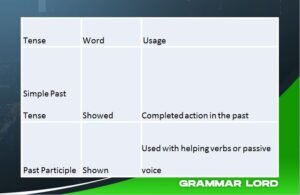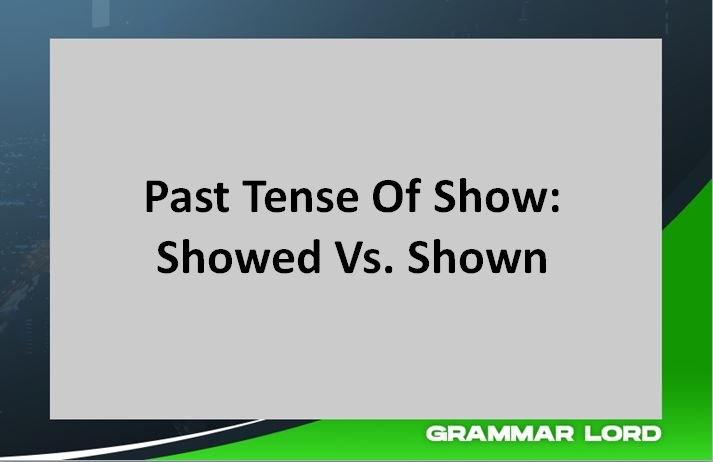The improper use of “showed” and “shown” is a common grammatical error. These two forms of the verb “show” have different functions. Showed is used to describe a past action, while shown is typically used with helping verbs.
However, this guide will explain the differences between these two forms and provide examples to help you use them correctly in your writing.
READ ALSO: What Is The Plural Form Of Bison
Contents
What Are The Differences Between Showed And Shown?

Understanding the difference between showed and shown can be misleading, even for native English speakers as these two words are both forms of the verb “show,” but they have different purposes in a sentence.
Showed is the simple past tense of the verb “show.” We use it to describe a completed action that happened in the past.
For Example:
-
“I showed him the picture yesterday.”
-
“She showed up late for the meeting.”
Shown, on the other hand, is the past participle of “show.” It’s often used with helping verbs like “have,” “has,” or “had” to form perfect tenses.
For instance:
-
“He has shown me great kindness.”
-
“The movie had already been shown when we arrived.”
You can also use “shown” after the verb “be” to form the passive voice.
Let’s take for example:
-
“The results were shown in the graph.”
In a nutshell, showed is used for a completed action in the past, while shown is generally used with helping verbs or in the passive voice.
READ ALSO: What Is The Plural Of Lettuce
When To Use “Showed”
Here are some common situations where you would use “showed”:
To describe a single completed action:
-
“I showed him the photo yesterday.”
-
“She showed up late for the party.”
To recount past events:
-
“We showed them the new house last weekend.”
-
“The teacher showed us how to solve the equation.”
To express a past condition or state:
-
“The symptoms showed up after he ate the shellfish.”
-
“The movie showed a lot of violence.”
However, do not forget that, “showed” is used for actions that have already happened and are finished.
It’s not used for ongoing or future actions.
When To Use “Shown”
Unlike “showed,” which is used for completed actions in the past, shown is the past participle of “show.” It’s often used with helping verbs like “have,” “has,” or “had” to form perfect tenses. Also, It can be used in the passive voice.
Using “Shown” With Helping Verbs
Present Perfect Tense:
This tense is used to talk about actions that started in the past and continue to the present.
Eg: “The movie has been shown three times this week.”
Past Perfect Tense:
We use this tense to talk about actions that were completed before another action in the past.
Example: “They had shown the visitors around before the meeting started.”
Future Perfect Tense:
The future perfect tense is used to describe actions that will be completed at a specific time in the future.
Example: “By next week, we will have shown everyone the new product.”
Using “Shown” In The Passive Voice
The passive voice is used when the focus is on the action rather than the person who acts.
-
“The results were shown in the graph.”
-
“The students were shown how to use the software.”
That said, while “shown” is often used with helping verbs or in the passive voice, it can also be used in other constructions, such as after certain verbs like “get,” “become,” or “seem.”
For Example: “He got shown the door.”
READ ALSO: What Is the Plural Form Of Peach
Common Mistakes With “Showed” And “Shown”
We used to make mistakes when using “showed” and “shown.” And, these errors often occur due to confusion about the past tense and past participle forms of the verb “show.” Understanding these common mistakes can help you avoid them in your writing.
Confusing “Showed” And “Shown”
One of the most common mistakes is confusing “showed” and “shown.” As we’ve said, “showed” is the simple past tense, used for completed actions, while “shown” is the past participle, typically used with helping verbs or in the passive voice.
- Incorrect: “I have shown the report yesterday.”
- Correct: “I showed the report yesterday.”
Overusing “Shown”
Another common error is overusing “shown.” While it’s adaptable, it’s not always the best choice. Sometimes, “showed” is more appropriate.
- Incorrect: “The results were shown to be inaccurate.”
- Correct: “The results showed that they were inaccurate.”
In addition, the passive voice can be misused with “shown.” Make sure that the sentence structure is correct.
- Incorrect: “The information was shown by the speaker.”
- Correct: “The speaker showed the information.”
These are some of our common mistakes, which can help you improve your grammar and avoid confusion in your writing.
READ ALSO: What Is The Past Tense Of Drive?
FAQs About “Showed” And “Shown”
What Is The Difference Between “Showed” And “Shown”?
“Showed” is the simple past tense of the verb “show,” used for completed actions in the past. “Shown” is the past participle, typically used with helping verbs like “have,” “has,” or “had,” or in the passive voice.
When Do I Use “Showed”?
Use “showed” to describe a single action that happened at a specific point in the past. For example, “I showed him the picture yesterday.”
When Do I Use “Shown”?
Use “shown” with helping verbs (have, has, had) to form perfect tenses or in the passive voice. For example, “The movie has been shown twice this week.”
What Are Some Common Mistakes People Make With “Showed” And “Shown”?
Common mistakes include confusing “showed” and “shown,” overusing “shown,” and incorrect use of “shown” in the passive voice.

